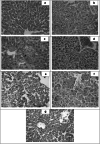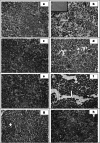Remarkable histopathological improvement of experimental toxoplasmosis after receiving spiramycin-chitosan nanoparticles formulation
- PMID: 35299902
- PMCID: PMC8901813
- DOI: 10.1007/s12639-021-01431-9
Remarkable histopathological improvement of experimental toxoplasmosis after receiving spiramycin-chitosan nanoparticles formulation
Abstract
The present study investigated the anti-Toxoplasma effect of chitosan nanoparticles [CS NPs], spiramycin, spiramycin co-administered with metronidazole and spiramycin-CS NPs formulation on the parasite burden and histopathological changes in the liver, spleen and brain in experimentally infected mice. Seventy male Swiss albino mice were classified into seven equal groups: healthy control (I), infected untreated control (II), infected group receiving CS NPs (III), spiramycin administered infected group (IV), infected group receiving spiramycin-metronidazole (V), infected receiving 400 mg/kg spiramycin-CS NPs (VI) and infected treated with spiramycin-loaded CS NPs 100 mg/kg (VII). All groups were inoculated intraperitoneally with 2500 T. gondii tachyzoites RH strain except the healthy control group. All groups were sacrificed on the 8th day after infection. Density of the parasite and histopathological examination of the liver, spleen and brain of all treated mice revealed reduction in the mean tachyzoites count as well as decreased inflammation, congestion and necrosis within tissue sections. Spiramycin-loaded NPs displayed the highest significant reduction in the pathological insult tailed by spiramycin-metronidazole and CS NPs. In conclusion, spiramycin-loaded CS NPs showed a promising synergistic combination in the treatment of the histopathology caused by toxoplasmosis.
Keywords: Chitosan nanoparticles; Spiramycin; Spiramycin-chitosan nanoparticles formulation; Spiramycin-metronidazole; Toxoplasma gondii.
© Indian Society for Parasitology 2021.
Conflict of interest statement
Conflict of interestThe authors declare that there is no conflict of interest.
Figures






References
LinkOut - more resources
Full Text Sources
